Abstract
Sustainable food production in protected cropping is increasing rapidly in response to global climate change and population growth. However, there are significant knowledge gaps regarding energy consumption while achieving optimum environmental conditions for greenhouse crop production. A capsicum crop cultivated in a high-tech greenhouse facility in Australia was analysed in terms of relationships between key environmental variables and the comparative analysis of energy consumption during different seasons. We showed that daily energy consumption varied due to the seasonal nature of the external environment and maintenance of optimal growing temperatures. Total power consumption reported throughout the entire crop cycle for heating (gas hot water system) and cooling (pad and fan) was 12,503 and 5183 kWh, respectively; hence, heating consumed ca. 70% of the total energy requirement over the 8-month growing period (early spring to late autumn) in the greenhouse facility. Regressions of daily energy consumption within each season, designated either predominantly for heating or cooling, indicated that energy consumption was 14.62 kWh per 1 °C heating and 2.23 kWh per 1 °C cooling. Therefore, changing the planting date to late spring is likely to significantly reduce heating energy costs for greenhouse capsicum growers in Australia. The findings will provide useful guidelines to maximise the greenhouse production of capsicum with better economic return by taking into consideration the potential optimal energy saving strategy during different external environment conditions and seasons.
1. Introduction
Sustainability in food production is one of the major concerns of growers, consumers and governments, including the need to reduce environmental impacts [1], which are dependent on the type of produce [2] and compost produced from agricultural waste [3]. This concern has been exacerbated in recent times, due to increasing population leading to greater food demand [1,4], increasing business competitiveness, as well as the sustainability of economic development and social well-being [5]. Various factors contribute to scarce food supply, including the impacts of rising population, climate change, environmental pollution, land contamination, and urbanisation [6,7]. In order to address this global challenge, protected cropping in horticulture has been rapidly adopted by farmers and growers in recent years [8,9,10].
Protected cropping has attracted increased attention across the world, due to advances in greenhouse technology, meeting increased demand for fresh horticultural produce [1], better utilisation of water, fertiliser and power consumption [11], and meeting consumer demand for a wide range of fresh produce throughout the year [12]. Furthermore, high-tech protected cropping is characterised by high quality and yield of produce, irrespective of climate, weather and soil conditions [13], increased reliability of fresh produce supply, and increased choices/options for alternative packaging and presentation with enhanced shelf life [14]. Significant reductions in traditional agricultural land areas have been replaced by increased protected cropping in many countries [15], evolving from very simple poly tunnels to complex industrial-type greenhouses in European countries [16] and rapid development of greenhouse vegetable production due to urbanisation [17]. It is evident from various studies on greenhouse food production that focus has been benchmarking of current practices as the basis for improving the protected cropping industry from the perspectives of energy consumption and environmental concerns [4], life cycle assessment of selected food production systems [18] and environmental and economic assessment of greenhouse crops in cold and warm climates [1]. These studies indicate that there are varying impacts of each protected crop on environment, depending of varying yield quantities and total energy consumption [2].
From the perspective of a comprehensive analysis of the food sector, particularly with the sustainability and management assessment of food production, life cycle assessment (LCA) methodology is recognised as an established approach for decision makers to gather data and information on environmental issues and use them to guide improvement strategies [19]. Using an LCA as a support tool to address sustainable production and consumption patterns, [19] proposed a knowledge base for the environmental assessment of an extended agricultural production area by combining organisation-specific tools. Many studies using LCA methodology provided comprehensive analysis of environmental impact in protected cropping taking consideration of energy use, carbon footprint and water footprint, with some comparisons of various crops, production situations and different crop types [3,19,20]. It was hypothesised that the environmental LCA ranking between local and imported vegetables might change depending on the impact category considered, using tomato as an example [20] while [3] using an LCA of open field and greenhouse cultivation indicated that the use of compost for fertilization improves overall sustainability in the agriculture sector. Recently, [4], using another LCA study of greenhouse tomato production, indicated that the industry needs to consider both growing biomass on degraded land and industrial symbiosis to recover wastes with appropriate strategies to provide environmentally and economically sustainable vegetables. Most of the studies using LCA on the sustainability of protected cropping provide useful guidelines for sustainable protected cropping under different climate conditions, energy and productivity trade-offs.
Although protected cropping provides a stable and controlled production environment, the energy required for cooling and heating is a major expense (second only to labour costs) for maintaining a sustainable business operation [21]. Nevertheless, studies on energy consumption in the protected cropping environment and its environmental impacts are relatively scarce. Some studies have analysed both energy use and environmental impacts using different protected cropping in different climate conditions, studies confined mainly to tomato, bean and cucumber production in European countries [2,22]. Many studies have shown varying levels of energy use and carbon footprint in protected cropping, with very positive overall outcome of energy use, environmental impact and productivity, proposition that energy use due to heating systems to compensate the greater environmental impact if productivity increases by 60% [2] and potential improvement options in reducing overall energy use, carbon footprint and water footprint, through trade-offs between three indicators [22].
Research studies focusing on high-tech protected cropping have reported mainly positive outcomes for limited types of crops in regions, such as western Europe and North America [23,24]; however, there is a limited understanding of best practices of protected cropping in the unique climate of Australia in the Southern Hemisphere. Hence, an effective management of the energy requirement and usage in the greenhouse facility is imperative to the sustainable protected cropping. Overall, most of the studies on the sustainability of protected cropping have shown positive outcomes in terms of meeting demand for fresh vegetables, but with a high environmental impact due to intense energy use, particularly in cold climates such as Canada [4]. However, the research investigation into sustainable protected cropping under warmer weather conditions and concentrated city living such as the Australian capital cities is lacking, which is the key focus of this paper.
In this study, we addressed the energy costs associated with producing capsicum in an environmentally controlled glasshouse facility. Capsicum annuum L. (Capsicum) is in the Solanaceae family (e.g., tomato, potato and eggplant) and is cultivated as an annual vegetable crop [25]. The most popular type of capsicum is the large bell pepper (capsicums), and snacking or mini capsicums have increased in popularity in recent years. The majority of capsicums that are hydroponically produced in greenhouses and controlled environments are sold as green, red, yellow, and orange varieties [26]. The scope of this case study was one cycle of capsicum crop production and its associated energy consumption. The key objectives of the research were to:
- (1)
- Understand daily energy consumption during the crop cycle, identifying key factors (e.g., peak daily energy consumption, average energy consumption, etc.);
- (2)
- Analyse energy consumption and yield data with climate conditions using key variables, particularly specific temperature ranges within and outside of the high-tech greenhouse facility, as the basis for improving current sustainable practices in protected cropping in Australia;
- (3)
- Compare energy consumption over three different stages of the crop production (seedling, flowering/fruiting, and harvesting) and three seasons (spring, summer and autumn) lifecycle as the basis for developing guidelines and strategies for sustainable protected cropping;
- (4)
- Compare daily cooling, heating and total energy consumption over associated periods, predominantly identified as cooling, heating and mixed cooling/heating seasons, respectively.
The remainder of the paper is structured as follows: research methodology, outlining methods and models used for data collection and analysis is presented. This is followed by analysis and results of the research, covering key analyses of energy consumption and temperature distribution over three stages of crop cycle and analysis of yield. Discussion on research findings is presented next, with reference to other studies in different geometrical contexts. Finally, conclusions drawing on research findings are made along with future research directions.
2. Research Methodology
2.1. Baseline Model
This research study used an analytical approach within broader life cycle assessment (LCA) to investigate energy consumption over a complete protected capsicum crop cycle in a large experimental high-tech greenhouse facility, so as to benchmark the industry and to recommend optimum crop cycles. The analytical approach was used to quantify energy consumption during the entire crop cycle, identifying key energy consumption measures associated with heating and cooling of the facility and forms the basis for optimising overall crop production cycle in a high-tech greenhouse facility. In this case, analyses were aimed at optimising the energy consumption, subject to environmental conditions, over the selected crop and cycle time. This was evaluated using data from the facility over one crop cycle of capsicum production. The analytical approach formed the basis for simulating the crop production cycle as a baseline model, which can later be extended to incorporate what-if scenarios within the broader research work in the future. Thus, details of the analytical approach adopted in this research is presented next.
2.2. Data Collection
The analytical approach used a complete cycle of protected crop production in a high-tech glasshouse facility. Data collection, including data collection methods and analysis of data associated with each step, are presented under each of the following steps.
Step 1: Identification of protected crop category and key parameters of the high-tech greenhouse facility and production
Capsicum plants were grown in natural light and photoperiod in a single greenhouse bay (420 m2) in the high-tech glasshouse facility at the National Vegetable Protected Cropping Centre, Western Sydney University (33.6000° S, 150.7500° E). The crop production cycle of three stages (seedling, flowering/fruits and harvesting) is over a period of 247 days, starting from 30 August 2017 and details of each stage are given in Table 1. The capsicum seedlings were propagated in a commercial nursery in Queensland, Australia. The sowing date was 5 July 2017 and the seedling date was 30 August 2017, which is 56 days from sowing to seedling transplant. Ten weeks after seedling transplanting, mature capsicum fruit harvesting was started. The total biomass of these plants is hard to estimate, as the pruning of vegetation and harvesting is conducted weekly. We do have a final biomass of the plants, which is on average 2.5–3.0 kg per plant. Our Priva system does not record Vapour Pressure Deficit (VPD); VPD values were measured by the LI-COR 6400 gas exchange analyser for capsicum leaves at 1.0–1.5 kPa. Transpiration is an effective part of cooling in addition to the evaporative pad and fan, which partially explains significantly less energy use required to cool the greenhouse.

Table 1.
Three stages of the crop production cycle.
The experimental trial was conducted from 30 August 2017 (Australian early spring) through summer to 4 May 2018 (late autumn), with three capsicum varieties from Syngenta-Waltz (red, 4 rows), Giallo (yellow, 3 rows) and 6412 (orange, 1 row). Plants were grown in Grotop Expert rockwool slabs (100cm L × 20cm W × 7.5cm H), with 4 plants per slab, and 3 stems per plant. The glasshouse bay consisted of a total of 255 slabs in 8 gutters, where each gutter contained 32 slabs (except for the last gutter with 31 slabs). Pest and disease management was executed by Integrated Pest Management, mainly using biological control agents. Fruit was harvested weekly and the total weight from each row and number of fruits were recorded. Data were calculated and the yield was expressed in kg/day or kg/m2 per year.
Step 2: Collect and calculate daily energy consumption during the crop cycle
Energy consumption was comprised mainly of cooling and heating of the facility during the entire crop production cycle. Heating was controlled by a hot water system and cooling was achieved using a pad and fan system. Key variables for measuring and evaluating energy consumption were recorded every 5 min during the entire cycle, by an automated control system (Priva, The Netherlands) that regulates environmental conditions, including temperature, CO2, humidity and fertilisation-irrigation throughout the production cycle.
The greenhouse facility uses a Priva Connnext system with v909 firmware labelled “Priva Connext 909 model system” as the process computer for protected horticulture. The Priva Connext 909 system provides digital outputs, which will actuate devices connected to it through relevant relays and contactors. Thus, the Priva system provides the central management and coordination of all processes in the field of climate, light, irrigation, water, and energy management. It automates anticipated conditions and events that affect the cultivation, inside and outside the greenhouse facility. Priva Connext 909 controls gas distribution, heat management, CO2 management and electricity management, with interfaces to external devices such as motors, fans and pumps. The system is operated with Priva Office Direct, the operating enables setting parameters, monitoring and adjusting processes. The Priva Connext software calculates energy flow in and out of each compartment based on a combination of settings in the system (responsibility of the engineer who commissioned the project) and measurements obtained through sensors. For example, weather factors are measured through a weather station measuring wind speed, wind direction, temperature, humidity, light (W/m2), and rain. Conditions in each compartment are measured using sensors that measure temperature and humidity in each compartment as well as energy flow into and out of each compartment via temperature sensors in the heating system. Further details on how energy flows are measured and calculated are provided in Appendix B.
The cooling of the facility was facilitated through a combination of fan and pump systems used to circulate cold water. In the greenhouse facility, a pad and fan cooling system was used to reduce the room temperature. Air is pulled mechanically through a wetted pad wall by fans in the opposite wall. Due to the adiabatic cooling of the air in the wet pad, the temperature will drop and can then be used to cool the greenhouse. The 6 electric motor-powered fans at the front side of the greenhouse facility are of type variable speed fans. The total amount of air when running at maximum capacity is expected to be 42,000 m3/h, which means that each fan has a capacity of 7000 m3/h. An energy meter Electronic Design and Manufacturing International (EDMI) Mk6 was used to monitor the energy consumption by all the fans. Details of key variables associated with cooling are shown in Table A1, which is similar to report in [27]. Heating of the facility requires heating and circulating water through two networks of water pipes (Return 1 and Return 2) (Table A2). Details of the heating system, including a description of key variables and the unit of measures, are given in Table A2. There are two heating systems using water lines: 1 (wall) and 2 (floor); there is no heating demand during the summer. The heating pump has a power rating of 0.17 kw and is single phase: one for wall and one for floor. Since power consumption was recorded at 5-min intervals, average consumption was evaluated using meter readings of respective systems (Floor and Wall). The electricity used for pump on and off for hot water pipes is calculated based on the difference of kWh captured between two timestamps in a 5-min interval. Hence, the calculation provides precise energy consumed to operate the pump for heating through hot water circulation. Priva Connext v909 system captured all climate and energy related measures in every 5-min interval. Based on these records over the complete crop cycle, daily measures of energy consumption (heating and cooling) and average measured temperature were calculated by aggregating 5-min records of each day.
3. Data Analysis and Results
3.1. Analysis of Cooling, Heating, Power Consumption and Yield Data
Cooling and heating are fundamental aspects of the protected cropping facility, so temperature settings associated with cooling and heating are considered first. The cooling system uses a combination of fans (six of them running concurrently) and pumps to maintain the desired temperature in the facility (Temperature Fan & Pump active) for optimal plant growth (Figure 1). It was noted from daily every 5-min records that each active (ON) state of pump corresponds with an active state of fan for the same period. This indicates that cooling systems (fans and pumps) are synchronised well to maintain desired temperatures. Since the system is set-up to run fans first and then the pump if required, the average number of times that fans operate was greater than the number of active pumps, throughout the cycle of operation. This indicated efficient operation of the cooling system that was subject to a significant range of external temperatures during the 8-month crop cycle. The heating of the facility was generated by two heating systems (wall and floor) using hot water, so we evaluated the water temperature at the entry and exit points of both systems (Wall and Floor).
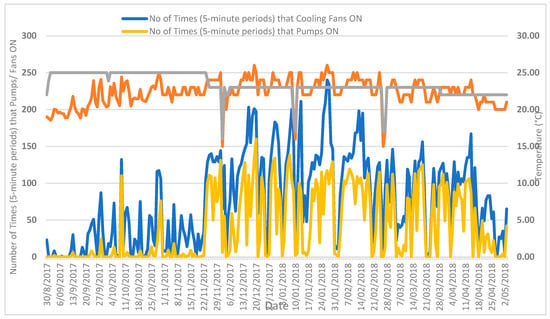
Figure 1.
Active and measured temperatures and power consumption by fan and pump cooling systems over the full capsicum crop lifecycle.
3.2. Overview of Temperatures and Power Consumption of a Greenhouse Capsicum Crop Cycle
Heating was very active at the start and end of the capsicum crop growth cycle, reflecting natural climate conditions during these times. Similar to the cooling systems, the heating systems were able to maintain temperatures required for optimum plant growth and high yield, compared to crop production under natural environmental temperature conditions (Figure 2). Since the temperature range during the plant cycle is large, there is considerable heating power consumption during those times (Figure 2). We found that the measured temperature closely aligns with the set temperature, with only small deviation between the two temperatures, indicating effective cooling and heating systems in the high-tech greenhouse facility. The difference between maximum temperature of the environment outside of the greenhouse and measured temperatures of the indoor conditions of the greenhouse ranged from −6.3 °C (i.e., on the coldest day, 4 November 2017 where maximum outside temperature was 6.3 °C below measured inside temperature) to 21.3 °C (i.e., on the hottest day, 7 January 2018 where maximum outside temperature was 21.3 °C higher than measured inside temperature) (Figure 3), indicating a broader temperature range outside the facility. This wide temperature range resulted in the frequent use of both heating and cooling to achieve optimum temperatures in the facility. The cumulative total kWh consumption for the day by both wall and floor systems for heating and the cumulative power consumption by a combination of fan and pump systems used to circulate cold water for heating recorded in the Priva Connext 909 system were used to calculate total power consumption. The total power consumption reported throughout the entire plant cycle for heating and cooling was 12,503 and 5183 kWh, respectively; hence, heating consumed ca. 70% of the total energy requirement over the 8 month growing period (early spring to late autumn) in the facility.
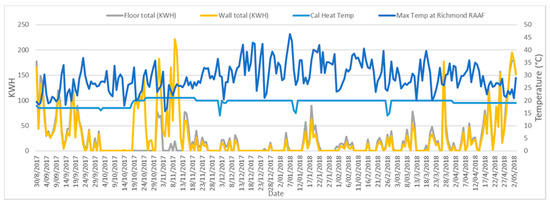
Figure 2.
Active and measured temperatures and power consumption by fan and pump cooling systems over the full capsicum crop lifecycle.
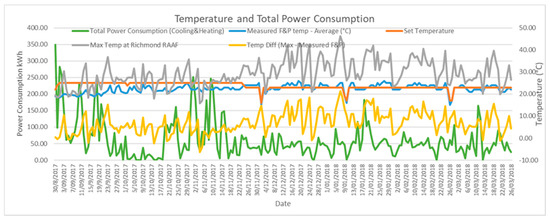
Figure 3.
Temperature and power consumption over the full capsicum crop lifecycle.
3.3. Analysis of Energy Cost Based on Plant Growth Stages
When total power consumption across the entire cycle was considered, irrespective of internal set-point and external outside temperatures of the facility, there was always power consumption (Figure 3). Significant variation of power consumption throughout the cycle was mainly due to a significant temperature difference between the maximum outside temperature and measured temperature in the facility of each day. In order to explore power consumption from the perspective of different stages of crop production lifecycle, further analysis of temperature and power consumption is carried out, using analysis of each stage, as the basis for determining the effect on shifting the production lifecycle. In this case, three crop development stages are identified as plant developing (seedling), flowers/fruits and harvesting. Details of these three stages are given in Table 1.
The initial plant development (seedling stage) exhibited the highest average power consumption per day (107.46 kWh), compared to those of the other two stages (55.38 and 68.61 kWh), which can be attributed to the cold weather at this growth stage (Table 2). Although the flowering and fruiting stage normally consumes higher energy than other stages, due to the warm season of the current experiment at this stage, the energy consumption is significantly lesser than in the seedling stage. Furthermore, the total power consumption for heating (3321.00 kWh) was 96.6% of the total energy consumed in the seedling stage; hence, shifting the seedling stage to a few weeks later when the outside temperature is higher would greatly reduce the daily power consumption for heating but would increase cooling costs. There was a very strong positive relationship between total cooling power consumption and temperature difference (maximum measured temperature), with a correlation of 0.76, indicating that maintenance of cooler temperatures during warm periods significantly increased power consumption (Table A3, Table A4 and Table A5). Cooling and heating parameters/measures were highly correlated with the temperature (both measured and the difference between maximum and measured); positive correlations were observed for total cooling power consumption and negative correlations observed for total heating power consumption (Table 3). Hence, the choice of planting dates and the relative difference between outside and inside temperatures should be considered when assessing the potential cost of energy consumption in a temperature-controlled greenhouse facility.

Table 2.
Descriptive measures of total daily power consumption (Cooling and Heating both in kWh) during three stages of the capsicum crop cycle.

Table 3.
Correlation between key variables and measures in three stages of the capsicum crop.
3.4. Analysis of Energy Cost Based on Seasons
The analysis of energy consumption should consider both temperature differentials and seasonal perspectives. In this study, we have three distinct periods of energy consumption: predominantly cooling, predominantly heating, and mixed cooling and heating energy consumption periods. Spring and winter are considered to be predominantly heating seasons, while summer is a predominantly cooling period. Autumn represents a combination of both cooling and heating. In the case of the crop production period in this study (247 days from 30 August 2017 (early spring) through summer to 3 May 2018 (late autumn)), three seasons are represented with respective heating, cooling and total energy consumption periods (Figure 4). Temperature differentials were considered for the analysis of energy consumption in the different periods (Table A6).

Figure 4.
Weather seasons mapped with average external temperature and internal measured temperature in the greenhouse.
Since total crop lifecycle is divided into three different energy consumption periods (zones) of heating, cooling and total power, energy consumption per degree of heating, cooling and total power is based on the temperature differentials of Diff G, Diff D and Diff C, respectively (Table A6). The selection of different temperature differentials is based on the relationship between temperature differential and the type of main power consumption in each zone. For example, the heating zone is directly related to the cool weather season, which is benchmarked with the minimum temperature, while the cooling zone is directly related to a warm/hot weather season, which is benchmarked with maximum outside temperature. In addition, the temperature differential of Diff E is used to test the significance of temperature difference in the facility (set-measured) with maximum outside temperature. Diff F is used for the regression of respective energy consumption (cooling, heating, total) during each season with temperature differential, for providing growers with a model for estimation of energy consumption per degree of cooling, heating or total, depending on the season.
3.5. Analysis of Cooling, Heating and Total Energy Consumption Cross Seasons for Crop Management Decision Making
In order to better understand the energy consumption from the perspective of temperature differentials and associated weather seasons, and to provide practitioners with guidelines for making evidence-based decisions on protected cropping under various decision variables, daily energy consumption was analysed and compared using descriptive statistics and regression analyses.
Figure 5 shows daily heating, cooling and total energy consumption during respective seasons. Similarly, descriptive statistics of daily heating, cooling and total energy consumption of respective weather seasons are shown in Table 4. It can be noted from Figure 5 and Table 4 that daily heating energy consumption is significantly higher than that of daily cooling energy consumption over comparable periods (i.e., 93 days of predominantly heating and 90 days of predominantly cooling). It is interesting to note that daily total energy consumption during autumn (60 days) was significantly higher than (i) total energy consumption during spring and summer combined, and (ii) the sum of daily cooling energy consumption in summer and daily heating energy consumption during spring. From the daily energy consumption perspective, summer (a predominantly cooling period) has the lowest daily energy consumption compared to autumn and spring (a high-heating period). Since daily heating energy consumption was much higher than cooling, there is potential for saving energy by delaying the crop cycle by a few days. From the total energy consumption perspective, it is shown (Table 5) that heating consumption is 88%, 31% and 78% of total energy consumption in spring, summer and autumn, respectively, compared to cooling energy consumption of 12%, 69% and 22%, respectively, in spring, summer and autumn. These results show that heating is predominant in both the spring and autumn seasons, while cooling energy consumption is predominant in the summer season. In order to explore this potential advantage further, energy consumption per degree of heating and cooling in respective weather seasons and regression analyses of energy consumption were conducted.
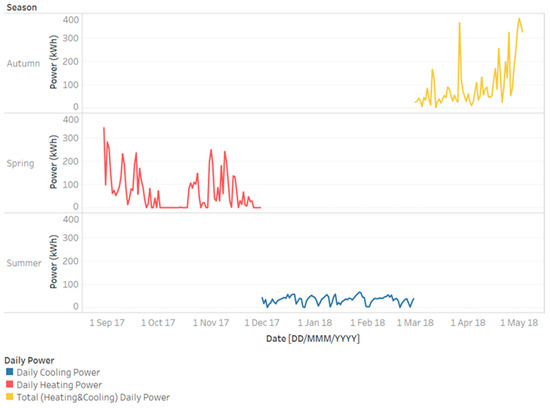
Figure 5.
Weather seasons mapped with daily heating in spring, cooling in summer and total energy consumption in autumn in the greenhouse.

Table 4.
Total energy consumption in each of the four seasons during the full capsicum crop cycle.

Table 5.
Three categories of energy consumption over four seasons, months and the energy consumption category.
Energy consumption was considered during the crop production period, using three distinct categories (heating, cooling and total) over four seasons (Table 5) to calculate daily consumption, including heating and cooling energy consumption per degree of heating and cooling, respectively. Figure 6, Figure 7 and Figure 8 show calculated liner regression of daily heating (R2 = 0.46), regression of cooling (R2 = 0.45) and regression of total energy consumption (R2 = 0.54) with temperature differential in respective weather seasons.
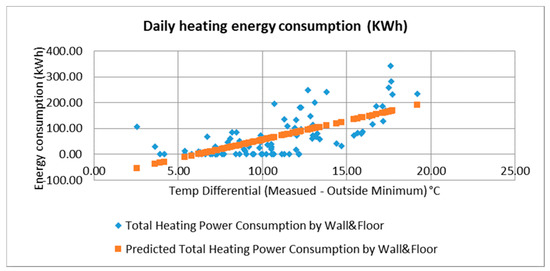
Figure 6.
Comparison of heating energy consumption and temperature differentials. Daily heating energy consumption vs. temperature differential (outside minimum—measured in the greenhouse).
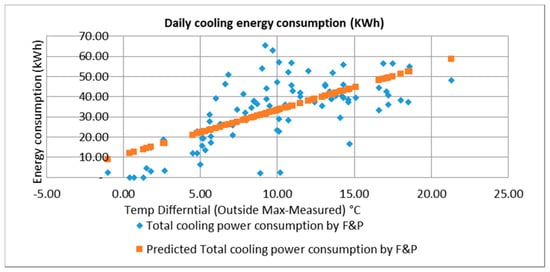
Figure 7.
Comparison of cooling energy consumption and temperature differentials. Daily cooling energy consumption vs. temperature differential (outside max—measured in the greenhouse).
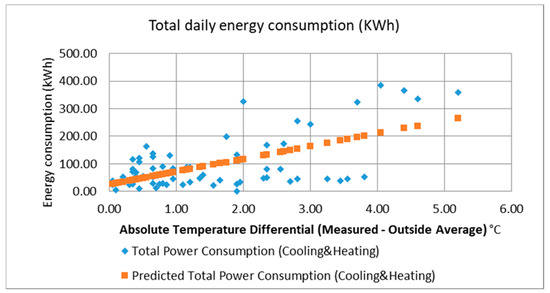
Figure 8.
Comparison of total energy consumption and temperature differentials. Daily total energy consumption vs. temperature differential (outside average—measured in the greenhouse).
Daily energy consumption was a function of temperature differentials, so regressions of energy consumption with temperature differential were conducted for spring, summer and autumn (Table A7). Based on the regressions of daily energy consumption in each season, energy consumption was 14.62 KWh per 1 °C of heating and 2.23 KWh per 1 °C of cooling. In order to compare total energy consumption during these seasons, descriptive statistics were evaluated and shown in Table 4. Using a pad and fan system for cooling, the facility in summer used the least amount of energy, while, in spring, it used the most energy.
3.6. Analysis of Crop Production
The capsicum crop was planted on 30 August 2017, and the final harvest occurred on 4 May 2018. Initial harvesting began on 11 November 2017, approximately 80 days after planting, and continued for about 6 months (180 days). The results show that the harvesting period of the crop is significantly longer than that in field crop production [28,29]. During the harvest period (8/9/2017–7/5/2018), average daily capsicum yield was approximately 30 kg per day, although it was variable. The significantly higher daily capsicum harvest (spike) shown at the end of the harvesting cycle reflects the harvest of all yield, which included both mature and immature fruits at the end for the cycle (Figure 9). The calculated capsicum yield in this study was 5.4 kg fruits per plant, which is more than 5-times greater than the 1.0 kg fruits per plant in the field [29]. Moreover, the calculated capsicum yield in this study was 53.1 kg fruits per m2, which is higher than previously reported for glasshouse capsicum production at up to 17.7 kg fruits per m2 [30,31,32].
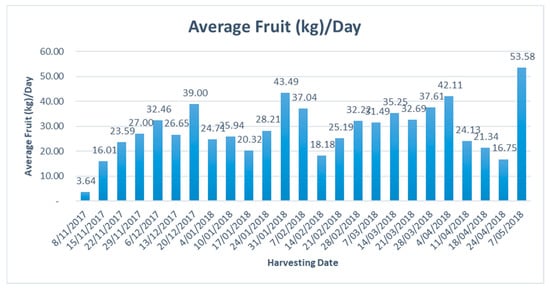
Figure 9.
Calculated daily average fruit yield of the capsicum crop in a high-tech greenhouse over the 2017–2018 growth season in Richmond, New South Wales. The value at 7 May 2018 was the average fruit yield per gutter of the final harvest, which is the highest due to the inclusion of all fruits from the crop.
4. Discussion
Energy efficiency is crucial to sustainable protected cropping food production. There are numerous studies on the technological advancements to improve energy use efficiency through new photovoltaic materials, LED lighting, novel greenhouse covering materials, novel cool technologies, and efficient heating systems [21]. Given the increasing demand for a year-round supply for high-quality vegetables, it is inevitable to utilise high-tech greenhouses with high yield potential but also associated high energy cost, especially in the cold and hot climate regions across the world. Although protected cropping is a viable and successful option to meet the demand for high-quality fresh vegetables and fruits, the energy required for cooling and heating is a major expense for maintaining a sustainable operation for many growers. Hence, we investigated energy consumption during a normal crop production period. The analysis of environmental/climate conditions of the selected protected cropping cycle showed that this high-tech facility exhibited excellent environmental control [33,34], which contributed to a higher yield than many larger-scale commercial greenhouses, which are often more than 5 ha in size (50,000 m2). In this study, the analysis of energy consumption over the capsicum production cycle indicates that daily energy consumption varies, due to the seasonal nature of varying temperature and the need for maintaining desirable temperatures. Although energy consumption may be higher in protected cropping, the yield is greater than when growing outdoors [10,29,30,31], so protected cropping should be considered within a long-term (e.g., 5–10 years) economic perspective and investment return [8,9]. Therefore, we suggest that reducing heating costs may be achieved by changing the planting date based on the local climate conditions in different regions of Australia, and this may also apply to glasshouse facilities in other countries.
While this study indicates that significant heating is required to maintain the desired temperature for the capsicum crop at the greenhouse facility, investigation into selecting the crop, setting the cycle time with different start time/s and the possibility of other influences for changing cycle time is required for optimising the energy consumption. These results, when compared with those of normal horticulture capsicum yield, show that protected crop yields are significantly higher than a typical yield of 53.1 kg/m2 per year in a high-tech greenhouse facility (2000 m2) in Canada [34]. The high yield of capsicum over a six-month period of harvesting is attributed to meeting all required conditions over the entire life cycle of the crop, facilitated through a well-maintained greenhouse facility. Thus, the protected capsicum crop yield and associated crop cycle can be set as the reference for commercial protected cropping in the local context. Once these results are compared with the global standards, the cycle and yield results can even be considered as benchmarking in the global context. Implications of this research include the importance of assessing the impact of capsicum production cycle on overall yield performance, specifically in setting the start of the cycle, which can influence the optimum crop production cycle from both environmental and economic perspectives. Moreover, shifting the start of the crop production cycle will effectively reduce the energy consumption throughout the production; hence, meeting the objective of sustainable operation and reducing environmental impacts. Overall, it is expected that protected crop production provides desired and quality products within acceptable costs, but further energy analysis on different horticultural crops and using different energy saving technologies (e.g., novel covering materials and cooling systems) is required for making protected crop production more sustainable with minimum impact on the environment.
5. Conclusions
We assessed energy consumption over a 247-day growing period (early spring through summer into late autumn) for capsicum in a high-tech greenhouse facility at Western Sydney University in Australia. The overall energy consumed and the energy required for each of three planting stages (seedling, flowers/fruits, and harvesting) for cooling and heating were assessed and we determined correlation coefficients of key variables/parameters to explore the relationship between energy use and environmental/climate conditions. Energy consumption was strongly dependent on the meteorological condition with 70% of the energy consumed for heating (12,503 kWh) compared to 30% for cooling (5183 kWh) during the growth period. High demand for heating occurred during the seedling stage because planting was in a cooler season, suggesting that shifting the commencement of the crop cycle towards a warmer season might generate energy savings. Crop yield was much higher than generally observed in both glasshouse production and field conditions. This study facilitates the development of a dynamic protected cropping operational framework to effectively minimise energy requirements. In the future, different scenarios will be identified for computerised modelling and simulation to provide appropriate recommendations and guidelines to broader stakeholders, particularly farmers and growers, to reduce energy use and increase the profitability of glasshouse operations.
Author Contributions
Conceptualization, P.S. and Y.-C.L.; Data curation, W.L.; Formal analysis, Y.-C.L.; Funding acquisition, P.S., Z.-H.C. and D.T.; Investigation, P.S.; Methodology, P.S. and W.L.; Project administration, D.T., Z.-H.C.; Resources, P.S., Z.-H.C. and D.T.; Supervision, P.S.; Validation, W.L., Z.-H.C. and D.T.; Visualization, P.S. and Z.-H.C.; Writing—original draft, P.S.; Writing—review & editing, Z.-H.C., D.T., Y.-C.L. and W.L. All authors have read and agreed to the published version of the manuscript.
Funding
The study is funded by Horticulture Innovation Australia projects (MT13041, VG16070, VG17003, LP18000) and contributes to the objectives of the Cooperative Research Centre project Future Food Systems.
Acknowledgments
We would like to thank Jeroen van Loon and Marcus van Heijst at Priva Australia and Edgar Lopez at AIS Greenworks for providing technical information about the Western Sydney University greenhouse control systems, and Dasun Malaarachchi for assisting with the data visualisation.
Conflicts of Interest
The authors declare no conflict of interest.
Appendix A. Key Variables, Descriptive Statistics, and Correlation and Regression Analyses

Table A1.
Key variables of cooling at the protected crop facility.
Table A1.
Key variables of cooling at the protected crop facility.
| Variable | Unit of Measure | Description | Details |
|---|---|---|---|
| Fan and pump (F&P) active | Active or Non-active | Fan and Pump–ON/OFF | Water is circulated if required. Involves multiple stages. Variable F&P is a binary variable. Record of 1 means both fan and pump are ON. |
| Cooling active | Active or Non-active | Fan is ON/OFF | This is a binary variable. Record of 1 means fan is ON. |
| Meas F&P temp | Celsius (°C) | Measured F&P temperature | This is the measured temperature in the facility, also recorded under environmental measures. |
| Temp F&P active | Celsius (°C) | Temperature setting to activate cooling. | This temperature setting is changed as crop matures. This could be based on advice from growers. |

Table A2.
Water Heating, Data collection Period from 30/August/2017 to 5/May/2018 with two heating networks: Return 1 and Return 2.
Table A2.
Water Heating, Data collection Period from 30/August/2017 to 5/May/2018 with two heating networks: Return 1 and Return 2.
| Variable | Unit of Measure | Variable Description |
|---|---|---|
| Meas heat t | Celsius (°C) | The calculated value determined by Priva based on the user settings and other influences that have been included. |
| Meas return 1 (Wall) | Celsius (°C) | The measured water temperature on the return line of the heating pipes (at exit) on the wall. This measurement point is immediately prior to exiting the room |
| Meas wt 1 (Wall) | Celsius (°C) | The measured water temperature on the supply line of the heating pipes (at entry) on the wall. This measurement point is just at the entry of wall system to the room (same location as the exit point in the room) |
| Meas return 2 (Floor) | Celsius (°C) | The measured water temperature on the return line of the heating pipes (at exit) on the floor. This measurement point is just before the exiting the room |
| Meas wt 2 (Floor) | Celsius (°C) | The measured water temperature on the supply line of the heating pipes (at entry) on the floor. This measurement point is just at the entry of floor system to the room (same location as the exit point in the room) |
| Wall (system 1) total (KWH) | KWH | The cumulative total kWh consumption for the day of the wall heating. |
| Floor (system 2) total (KWH) | KWH | The cumulative total kWh consumption for the day of the floor heating. |

Table A3.
Daily cooling power consumption during three stages of the capsicum crop.
Table A3.
Daily cooling power consumption during three stages of the capsicum crop.
| Key Descriptive Statistics | Seedling | Flowers/Fruits | Harvesting |
|---|---|---|---|
| Mean | 3.68 | 8.54 | 26.79 |
| Standard Deviation | 5.59 | 10.35 | 16.12 |
| Range | 22.85 | 38.04 | 65.36 |
| Minimum | 0 | 0 | 0 |
| Maximum | 22.85 | 38.04 | 65.36 |
| Sum | 117.65 | 324.42 | 4741.73 |
| Count (No of days) | 32 | 38 | 177 |

Table A4.
Correlation between key variables and measures for the plants cycle.
Table A4.
Correlation between key variables and measures for the plants cycle.
| Measured F&P Temp-Average (°C) | Temp Diff (Max-Measured F&P Temp) | Total Cooling Power Consumption by Fan and Pump | Total Heating Power Consumption by Wall and Floor | Total Power Consumption (Cooling and Heating) | |
|---|---|---|---|---|---|
| Measured F&P temp-Average (°C) | 1.00 | ||||
| Temp Diff (Max-Measured F&P Temp) | 0.48 | 1.00 | |||
| Total cooling power consumption by Fan & Pump | 0.73 | 0.76 | 1.00 | ||
| Total Heating Power Consumption by Wall and Floor | −0.49 | −0.28 | −0.39 | 1.00 | |
| Total Power Consumption (Cooling and Heating) | −0.35 | −0.12 | −0.18 | 0.98 | 1.00 |

Table A5.
Descriptive measures of power consumption during the three plant developing stages.
Table A5.
Descriptive measures of power consumption during the three plant developing stages.
| Key Descriptive Statistics | Daily Power Consumption (Cooling)-kWh | Daily Power Consumption (Heating)-kWh |
|---|---|---|
| Mean | 3.68 | 103.78 |
| Standard Deviation | 5.59 | 89.71 |
| Range | 22.85 | 343.00 |
| Minimum | 0 | 0 |
| Maximum | 22.85 | 343.00 |
| Sum | 117.65 | 3321.00 |

Table A6.
Temperature differentials for energy consumption analysis.
Table A6.
Temperature differentials for energy consumption analysis.
| Temperature Differential | Definition |
|---|---|
| Diff A | Set temperature—Outside Average Temperature |
| Diff B | Maximum outside temperature—Set Temperature |
| Diff C | Measured temperature—Outside Average Temperature |
| Diff D | Maximum outside temperature—Measured Temperature |
| Diff E | Set temperature—Measured temperature |
| Diff F | Maximum outside temperature—Minimum outside temperature |
| Diff G | Measured temperature—Minimum outside temperature |

Table A7.
Outcomes of regression analyses of each energy consumption considered.
Table A7.
Outcomes of regression analyses of each energy consumption considered.
| Season/Main energy type | Temperature Differential | Daily Energy Consumption (KWh) | Regression Coefficients | Regression Equation |
|---|---|---|---|---|
| Spring/Heating | Measured-Min. Outside Temperature | Daily heating energy consumption | Multiple R: 0.68 R Square: 0.46 Intercept: −90.70 Gradient: 14.62 | Y = 14.62X − 90.70 |
| Summer/Cooling | Maximum Outside Temp-Measured | Daily cooling energy consumption | Multiple R: 0.67 R Square: 0.45 Intercept: 11.04 Gradient: 2.23 | Y = 2.23X + 11.04 |
| Autumn/Total energy | Measured-Outside Average Temp. | Daily total energy consumption | Multiple R: 0.61 R Square: 0.37 Intercept: 24.64 Gradient: 46.28 | Y = 46.28X +2 4.64 |
Appendix B. Details of Energy System Parameters, Measurement and Monitoring
The way the energy usage for the heating is calculated and measured all starts with the gas that is used. All over the world there are different types of natural gases and therefore there are different caloric values for those types of gas. The details used at Western Sydney University (WSU) S40 greenhouse are:
- Combustion value of natural gas:
- ○
- Lower: 31.65 MJ/m3
- ○
- Upper: 35.17 MJ/m3
When there is a gas meter that measures the gas that is consumed by the boiler, the efficiency of the boiler (setting used for the installation is 80%) can be simply worked out by determining how much energy is produced by the boiler. The boiler has an internal control that is responsible for its behaviour to maintain temperature. The used capacity in the Priva software for the boiler is 250 kW. The numbers above will result in the (theoretical) heat energy production. This energy production is then divided over the compartments as per the energy demands in those compartments. A breakdown in what is involved to get to the calculated figures can be found below. The consumers (heating nets in the compartments) will calculate the desired energy by using the area size, height (used as a factor), energy savings via movable or fixed screen/whitewash/energy coating on the glass, vent position, and so on, as well as external conditions. External conditions are radiation influence (adjusted by the translucency of the glass, 83% in the setup), wind speed, temperature and rain.
- The screen details used in the WSU greenhouse setup:
- ○
- Energy saving 45%
- ○
- Radiation limitation 50%
- ○
- Air exchange limitation 80%
- Energy saving based on the position of the screen:
- ○
- 1/8 at 70% screen cover
- ○
- 1/2 at 85% screen cover
The requirement to the heating system, translated into water temperature and pump speed (fixed speed in the WSU greenhouse setup) will then depend on the number of heating pipes and their diameter. This will then provide the specific capacity in W/(m2·°C) and specific area in a percentage.
- Specific capacity:
- ○
- 1.7 × (Pipe diameter [mm]/51) × (Number of pipes per cover/Roof width [m]). This is for round pipes only.
- ○
- Example 1 of the calculation of the Specific capacity:
- ○
- The pipe is round and has a diameter of 45 mm
- ○
- The cover width is 4 m
- ○
- There are 5 pipes per roof
- ○
- From the data above it appears that Formula 1 from the table above should be used. Completing the formula gives: Specific capacity = 1.7 × (45/51) × (5/4) = 1.9 W/(m2·°C)
- ○
- The formula above for the pipes gives us 2.1 W/(m2·°C) in compartments 1–9 for the floor pipes
- Specific area:
- ○
- Example of the calculation of the Specific area:
- ○
- The pipe is round and has a diameter of 51 mm (=0.051 m)
- ○
- The cover width is 3.2 m
- ○
- There are 4 pipes per roof
- ○
- From the formulas and data above the Specific area is determined as follows: Specific area = (4 × 0.051 × 100)/3.2) = 6.38%
- ○
- The number above is what is used in compartments 1–9 for the floor pipes
All of these calculations form the basis of the required energy in kW to get to the desired greenhouse temperature.
In a select number of compartments, there are also energy meters. This is a flow meter combined with a temperature sensor in the supply and return. Those temperature sensors will give us the ∆T. When you combine those numbers, you can work out the energy consumption of the heating net. The cooling system is essentially a heating net in reverse. The same logic as per above will apply. The only difference is that we do not use pipes to maintain greenhouse temperature, we use a fan driven heat exchanger. The supply water to the heat exchanger has a mixing valve so that the output can be modulated. This means that we cannot control the inlet but only the outlet temperature.
- The energy specifics of the air handling units (fan/heat exchanger unit) such as fan details as per WSU greenhouse settings:
- ○
- Fan motor: 1.8 kW
- ○
- Fan capacity: 4000 (m3/h)
- ○
- Pump capacity: 200 W
- ○
- Specific capacity: 33.7 W/(m2·°C)
- Those details were provided by ACIS during the commissioning of the job.
With the heating, we can calculate the specific capacity based on the supplied formula. In the case of air handling units, we rely on the supplier of those units:
- Indication of the energy delivery/continuity coefficient of a spiral, expressed in Watts per m2 of spiral area (the area setting indicated above for each degree Celsius difference between the spiral and air that runs along the spiral).
a. Electrical drawing of electrical panels
Figure A1 shows electrical drawing of both electrical panels where how all the devices are connected to different electrical elements and controlled from the Priva activations.
It should be noted that the distribution of energy consumption (heating) in the facility is described as follows:
- Different forms of energy are available for the different sources.
- The central sources such as the boiler, Heating Pump and the heat exchanger first supply the produced heat to the buffer (system dependent). The energy that arrives in the buffer from the start of the day onwards is converted into a gas equivalent using the natural gas equivalent conversion factor.
The consumption of the on/off heating group is allocated directly to the compartments.
- 3.
- Emptying the buffer makes the heat available in the compartments. In this example, at the end of the day not all the purchased energy has been consumed in the compartments. A small fraction is still left in the buffer. Only the fraction of the energy that has actually been consumed in the compartments is allocated to the compartments.
- 4.
- For the distribution of the sum of the gas equivalents, the dealer must link the air treatment systems present to the corresponding compartment and any autonomous heating systems to the corresponding compartments.
- 5.
- Internally, the control determines per compartment the sum of the heat capacity of the heating networks (compartment and autonomous) and the air treatment systems. If an (autonomous) heating control or air treatment control is located in several compartments at the same time, the ratio of the heated surfaces and the compartment surfaces is decisive.
- 6.
- The total of the gas equivalents consumed over all compartments is distributed among the compartments. This distribution is based on the ratio of the heat capacity sums. In this way, transport losses are spread across the various compartments.
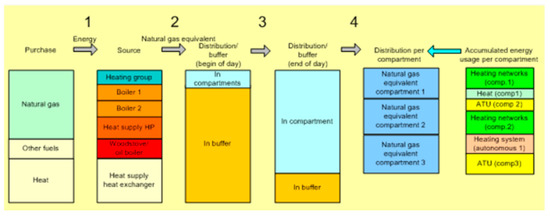
Figure A1.
Electrical panels and power distribution.
b. Monitoring and controlling electricity network import and export (EL3)
The EL3-Monitoring and controlling electricity network import and export module determines how much electrical capacity is currently allowed to be imported from the electricity network or has to be exported. Monitoring can be on the exceeding of an electricity import too high or of a too low electricity export. If sufficient growing light systems and/or electricity consumers are active and using the electricity network, it is possible that the import of electricity is controlled on a set maximum. Module EL3-Monitoring and controlling electricity network import and export tells module EM4-Distribution electricity demand amongst sources how much electrical capacity is allowed to be consumed from the electricity network for each moment. The minimum amount of electrical capacity to be exported is determined by module EAF1-Electricity consumer control. The total desired export capacity is summed for the total minimum capacity to be exported from all electricity consumers that are configured as the electricity network. The maximum electrical capacity to be exported (Set max electr.export, I204 Electr.Management/Monitoring) is determined by the lowest of the following three values:
- 2 Max electricity network capacity
- Absolute max electricity import
- Max import from current clock hour.
c. Monitoring minimum export electricity network
An export meter has to be allocated to be able to trigger alarms if too little electricity is exported. If a combined import/export meter already exists, in the current set up the modules.
d. Electricity management control
The electricity management is responsible for the production and distribution of electricity throughout the greenhouse. The structure is shown in Figure A2.
Figure A2 shows that a distinction is made between electricity consumers (growing light and cyclic lighting controls, electricity consumers and electricity demand recipients) and electricity producers (combined heat & power (CHP) and electricity network). Because growing light systems are not allowed to be switched on and off all at the same time, there is a separate control for the switching sequence. The electricity producers are remotely influenced by the power company with block signals (for switching on the CHP for supplying the electricity network (unbalanced ON), refer to the functionality of the heat management). Standard pulse meters can be used to register the electricity imported from, and exported to, the electricity net (see M306 Pulse meter). For registration of the CHP electricity production, a pulse meter can be allocated to each CHP. Pulse meters are not used to control the import of electricity; instead, a combined import/export meter is used, which is present in the electricity management as standard. When pulse meters are used for measurement, a one-time reduction in the import can be made. However, upward adjustment of import will never again take place automatically. The structure of electricity management is shown in Figure A3.
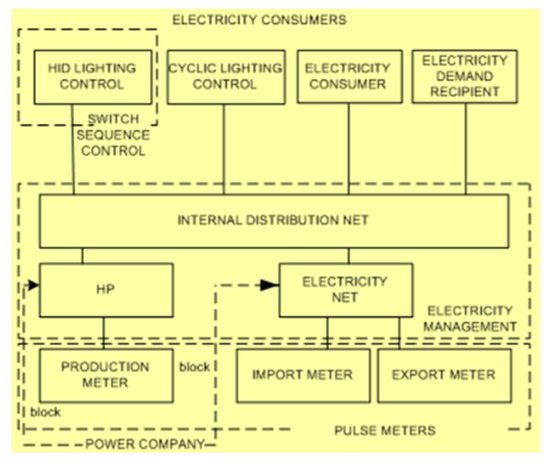
Figure A2.
General structure of the production and distribution of electricity.
e. Summary of electricity management
Using the figure summary of electricity management, the electricity management control can be summarised as follows:
- Demands from the connected lighting systems (growing light and cyclic lighting, electricity consumers and recipients of electricity demand) are collected in module EM1-Adjustment electricity demand to consumers. In addition, the electrical capacity that is available immediately is used in conjunction with the set sequence numbers for electricity consumption by the various lighting systems and electricity consumers to determining which lighting systems may be switched on.
- The maximum electrical capacity is determined for each source in module EM2-Limitation electricity production sources. This also uses the block-out signal for the relevant source or a central ‘unbalanced OFF’ signal that can switch off one or more CHPs simultaneously. In the case of the CHP it also checks whether it is being limited by any other causes (Limitation CHP).
- If possible, the imported electrical capacity is readjusted in module EL3-Monitoring and controlling electricity network import and export, if the measured import capacity exceeds the set import limit. This module also ensures that an alarm is generated if the maximum import capacity is exceeded or if insufficient capacity is exported.
- The collected electricity demand is distributed across the available electricity sources in module EM4-Distribution electricity demand amongst sources. In so doing, the maximum capacity and the electricity by-product (for CHPs only) of the relevant sources are taken into account.
- Based on electricity demand, the CHP control switches on an CHP.

Figure A3.
Structure of electricity management.
References
- Torrellas, M.; Antón, A.; Ruijs, M.; Victoria, N.G.; Stanghellini, C.; Montero, J.I. Environmental and economic assessment of protected crops in four European scenarios. J. Clean. Prod. 2012, 28, 45–55. [Google Scholar] [CrossRef]
- Zarei, M.J.; Navab, K.; Afshin, M. Life cycle environmental impacts of cucumber and tomato production in open-field and greenhouse. J. Saudi Soc. Agric. Sci. 2017, 18, 249–255. [Google Scholar] [CrossRef]
- Bartzas, G.; Zaharaki, D.; Komnitsas, K. Life cycle assessment of open field and greenhouse cultivation of lettuce and barley. Inf. Process. Agric. 2015, 2, 191–207. [Google Scholar] [CrossRef]
- Dias, G.M.; Ayer, N.W.; Khosla, S.; Van Acker, R.; Young, S.B.; Whitney, S.; Hendricks, P. Life cycle perspectives on the sustainability of Ontario greenhouse tomato production: Benchmarking and improvement opportunities. J. Clean. Prod. 2017, 140, 831–839. [Google Scholar] [CrossRef]
- Del Borghi, A.; Gallo, M.; Strazza, C.; Del Borghi, M. An evaluation of environmental sustainability in the food industry through Life Cycle Assessment: The case study of tomato products supply chain. J. Clean. Prod. 2014, 78, 121–130. [Google Scholar] [CrossRef]
- Rosenzweig, C.; Parry, M.L. Potential impact of climate change on world food supply. Nature 1994, 367, 133–138. [Google Scholar] [CrossRef]
- Gruda, N.; Bisbis, M.; Tanny, J. Impacts of protected vegetable cultivation on climate change and adaptation strategies for cleaner production–a review. J. Clean. Prod. 2019, 225, 324–339. [Google Scholar] [CrossRef]
- Bambara, J.; Athienitis, A.K. Energy and economic analysis for the design of greenhouses with semi-transparent photovoltaic cladding. Renew. Energy 2019, 131, 1274–1287. [Google Scholar] [CrossRef]
- Stanghellini, C.; Oosfer, B.; Heuvelink, E. Greenhouse Horticulture: Technology for Optimal Crop Production; Wageningen Academic Publishers: Wageningen, The Netherlands, 2019. [Google Scholar]
- Geilfus, C.M. Protected Cropping in Horticulture. In Controlled Environment Horticulture; Springer: Cham, Switzerland, 2019; pp. 7–17. [Google Scholar]
- Castilla, N.; Montero, J.I. Environmental control and crop production in Mediterranean greenhouses. In Proceedings of the International Workshop on Greenhouse Environmental Control and Crop Production in Semi-Arid Regions 797, Tucson, AZ, USA, 20–24 October 2008; pp. 25–36. [Google Scholar]
- Torrellas, M.; Antón, A.; López, J.C.; Baeza, E.J.; Parra, J.P.; Muñoz, P.; Montero, J.I. LCA of a tomato crop in a multi-tunnel greenhouse in Almeria. Int. J. Life Cycle Assess. 2012, 17, 863–875. [Google Scholar] [CrossRef]
- Flores, H.; Villalobos, J.R.; Ahumada, O.; Uchanski, M.; Meneses, C.; Sanchez, O. Use of supply chain planning tools for efficiently placing small farmers into high-value, vegetable markets. Comput. Electron. Agric. 2019, 157, 205–217. [Google Scholar] [CrossRef]
- Smith, G. An Overview of the Australian Protected Cropping Industry [EB/OL]. Available online: https://www.graemesmithconsulting.com/images/documents (accessed on 27 May 2019).
- Bae, K.S.; Chung, S.O.; Kim, K.D.; Hur, S.O.; Kim, H.J. Implementation of remote monitoring scenario using CDMA short message service for protected crop production environment. J. Biosyst. Eng. 2011, 36, 279–284. [Google Scholar] [CrossRef]
- Baille, A. Greenhouse structure and equipment for improving crop production in mild winter climates. In International Symposium Greenhouse Management for Better Yield & Quality in Mild Winter Climates. Acta Hort. 1997, 491, 37–48. [Google Scholar]
- He, X.; Qiao, Y.; Liu, Y.; Dendler, L.; Yin, C.; Martin, F. Environmental impact assessment of organic and conventional tomato production in urban greenhouses of Beijing city, China. J. Clean. Prod. 2016, 134, 251–258. [Google Scholar] [CrossRef]
- Blengini, G.A.; Busto, M. The life cycle of rice: LCA of alternative agri-food chain management systems in Vercelli (Italy). J. Environ. Manag. 2009, 90, 1512–1522. [Google Scholar] [CrossRef] [PubMed]
- Cellura, M.; Ardente, F.; Longo, S. From the LCA of food products to the environmental assessment of protected crops districts: A case-study in the south of Italy. J. Environ. Manag. 2012, 93, 194–208. [Google Scholar] [CrossRef]
- Payen, S.; Basset-Mens, C.; Perret, S. LCA of local and imported tomato: An energy and water trade-off. J. Clean. Prod. 2015, 87, 139–148. [Google Scholar] [CrossRef]
- Rabbi, B.; Chen, Z.H.; Sethuvenkatraman, S. Protected cropping in warm climates: A review of humidity control and cooling methods. Energies 2019, 12, 2737. [Google Scholar] [CrossRef]
- Almeida, J.; Achten, W.M.; Verbist, B.; Heuts, R.F.; Schrevens, E.; Muys, B. Carbon and water footprints and energy use of greenhouse tomato production in Northern Italy. J. Ind. Ecol. 2014, 18, 898–908. [Google Scholar] [CrossRef]
- Campiotti, C.; Viola, C.; Alonzo, G.; Bibbiani, C.; Giagnacovo, G.; Scoccianti, M.; Tumminelli, G. Sustainable Greenhouse Horticulture in Europe. J. Sustain. Energy 2012, 3, 1–5. [Google Scholar]
- Vadiee, A.; Martin, V. Energy management in horticultural applications through the closed greenhouse concept, state of the art. Renew. Sustain. Energy Rev. 2012, 16, 5087–5100. [Google Scholar] [CrossRef]
- Wubs, A.M.; Heuvelink, E.; Marcelis, L.F. Abortion of reproductive organs in sweet pepper (Capsicum annuum L.): A review. J. Hortic. Sci. Biotechnol. 2009, 84, 467–475. [Google Scholar] [CrossRef]
- Srinivasan, K. Biological activities of red pepper (Capsicum annuum) and its pungent principle capsaicin: A review. Crit. Rev. Food Sci. and Nutr. 2016, 56, 1488–1500. [Google Scholar] [CrossRef] [PubMed]
- Bonachela, S.; Quesada, J.; Acuña, R.A.; Magán, J.J.; Marfà, O. Oxyfertigation of a greenhouse tomato crop grown on rockwool slabs and irrigated with treated wastewater: Oxygen content dynamics and crop response. Agric. Water Manag. 2010, 97, 433–438. [Google Scholar] [CrossRef]
- Jolliffe, P.A.; Gaye, M.M. Dynamics of growth and yield component responses of bell peppers (Capsicum annuum L.) to row covers and population density. Sci. Hortic. 1995, 62, 153–164. [Google Scholar] [CrossRef]
- Díaz-Pérez, J.C.; Hook, J.E. Plastic-mulched bell pepper (Capsicum annuum L.) plant growth and fruit yield and quality as influenced by irrigation rate and calcium fertilization. HortScience 2017, 52, 774–781. [Google Scholar]
- Dufault, R.J.; Schultheis, J.R. Bell pepper seedling growth and yield following pretransplant nutritional conditioning. HortScience 1994, 29, 999–1001. [Google Scholar] [CrossRef]
- Rameshwaran, P.; Tepe, A.; Yazar, A.; Ragab, R. Effects of drip-irrigation regimes with saline water on pepper productivity and soil salinity under greenhouse conditions. Sci. Hortic. 2016, 199, 114–123. [Google Scholar] [CrossRef]
- Berkers, E.; Geels, F.W. System innovation through stepwise reconfiguration: The case of technological transitions in Dutch greenhouse horticulture (1930–1980). Technol. Anal. Strateg. Manag. 2011, 23, 227–247. [Google Scholar] [CrossRef]
- Aramyan, L.H.; Lansink, A.G.; Verstegen, J.A. Factors underlying the investment decision in energy-saving systems in Dutch horticulture. Agric. Syst. 2007, 94, 520–527. [Google Scholar] [CrossRef]
- Guo, X.; Hao, X.; Khosla, S.; Kumar, K.G.S.; Cao, R.; Bennett, N. Effect of LED interlighting combined with overhead HPS light on fruit yield and quality of year-round sweet pepper in commercial greenhouse. In Proceedings of the VIII International Symposium on Light in Horticulture 1134, East Lansing MI, USA, 22–26 May 2016; pp. 71–78. [Google Scholar]
© 2020 by the authors. Licensee MDPI, Basel, Switzerland. This article is an open access article distributed under the terms and conditions of the Creative Commons Attribution (CC BY) license (http://creativecommons.org/licenses/by/4.0/).